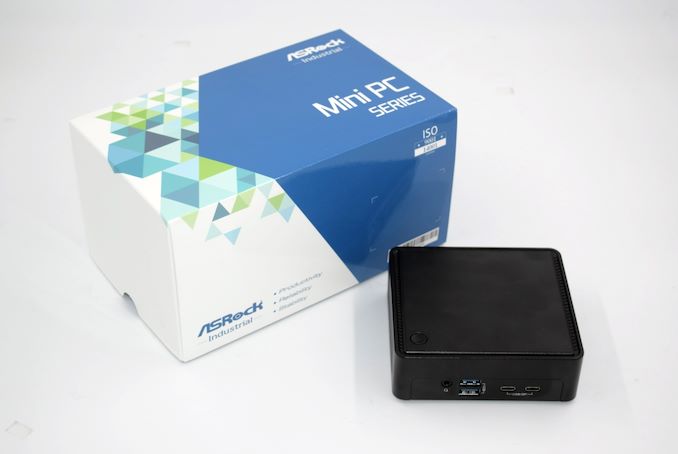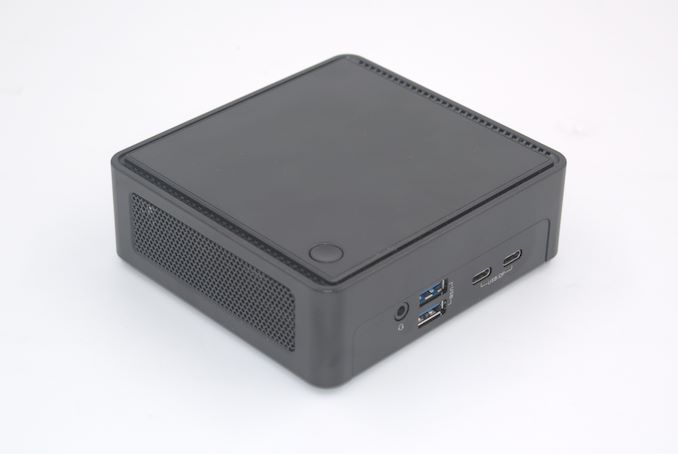ASRock Industrial NUCS BOX-1360P/D4 Review: Raptor Lake-P Impresses, plus Surprise ECC
by Ganesh T S on January 29, 2023 9:30 AM EST- Posted in
- Systems
- NUC
- UCFF
- Mini-PC
- ASRock Industrial
- Raptor Lake-P

Low-power processors have traditionally been geared towards notebooks and other portable platforms. However, the continued popularity of ultra-compact form-factor desktop systems has resulted in UCFF PCs also serving as lead vehicles for the latest mobile processors. Such is the case with Intel's Raptor Lake-P - the processor SKUs were announced earlier this month at the 2023 CES, and end-products using the processor were slated to appear in a few weeks. Intel is officially allowing its partners to start selling their products into the channel today, and also allowing third-party evaluation results of products based on Raptor Lake-P to be published.
ASRock Industrial introduced their Raptor Lake-P-based NUC clones as soon as Intel made the parts public. With the new platform, the company decided to trifurcate their offerings - a slim version (sans 2.5" drive support) with DDR4 SODIMM slots in the NUCS BOX-13x0P/D4, a regular height version with 2.5" drive support in the NUC BOX-13x0P/D4, and a slightly tweaked version of the latter with DDR5 SODIMM slots in the NUC BOX-13x0P/D5. The NUCS BOX-1360P is the company's flagship in the first category, and the relative maturity of DDR4-based platforms has allowed them to start pushing the product into the channel early.
ASRock Industrial sampled us with a NUCS BOX-1360P/D4 from their first production run. We expected a run of the mill upgrade with improvements in performance and power efficiency. In the course of the review process, we found that the system allowed control over a new / key Raptor Lake-P feature that Intel hadn't even bothered to bring out during their CES announcement - in-band ECC. This review provides a comprehensive look at Raptor Lake-P's feature set for desktop platforms along with with detailed performance and power efficiency analysis for SFF PC workloads.
Introduction and Product Impressions
Intel's Raptor Lake-P builds upon Alder Lake-P and its heterogeneous processor architecture by moving to a more efficient manufacturing process. Unlike the desktop version with improved cache size per performance core and doubled efficiency cores count, the -P series provides improvements essentially from the updated V-F curves. This has allowed Intel to increase the turbo clocks for both core types to deliver better performance and power efficiency - all while retaining the same 28W nominal TDP of Alder Lake-P. There are also a number of I/O improvements such as additional Thunderbolt 4 ports and USB 3.2 Gen 2x2 support on them, but the adoption of those are dependent on other board component choices by the system manufacturer.
ASRock is a well-known vendor in the consumer PC market. In 2011, the company set up the ASRock Industrial business unit to focus on industrial motherboards. The division branched out in 2018 as an independent vendor with exclusive focus on B2B products. The company has products for deployment in small businesses (offices), automation, robotics, security, and other industrial / IoT applications. Primarily, the company develops motherboards, and sells them to various system integrators who can do their own value additions. Additionally, the company also sells mini-PCs based on the developed motherboards into the retail channel. We have taken a close look at the performance profile of various ASRock Industrial UCFF PCs before, including that of the NUC BOX-1260P based on the Core i7-1260P Alder Lake-P processor.
The company provided us with a sample of their first Raptor Lake-P mini-PC - the NUCS BOX-1360P/D4. This is essentially a follow-up product to the NUC BOX-1200 series, but not exactly a drop-in replacement. While the NUC BOX-1200 series came with dual LAN capabilities, and a choice of both HDMI and Display Port outputs, the NUCS BOX-1300 series replaces the Display Port output with another HDMI port and does away with one of the LAN ports.
While the NUC BOX series uses a chassis tracing its roots back to ASRock's now defunct Beebox product line, the NUCS BOX is a first for ASRock Industrial. Without the need to support a 2.5" drive, the chassis height has been cut down from 48mm to 38mm. The original fingerprint magnet of a chassis top has also been replaced with matte plastic. The relative distance between the motherboard and the chassis top has not been altered, though (the height reduction is completely on the underside where the 2.5" drive caddy used to be placed). The cooling solution for the processor is time-tested within that case design, and all that ASRock Industrial has done for the NUCS BOX-1300 series is to alter the I/O cut-outs slightly to match the new board.
ASRock Industrial's main focus is on B2B customers. It is no surprise that their systems are packaged in a nondescript manner. However, within the package, the company includes everything that an end-user would need - a VESA mount and associated screws, M.2 SSD installation aids, a geo-specific power cord and a 90W power adapter.
ASRock Industrial markets their mini-PCs in a barebones configuration, with the choice of RAM and SSD left to the end user. Installing these components involves removing four screws from the underside of the unit and slotting in the SODIMMs and affixing the M.2 SSD with a screw. It must be noted here that the M.2 SSD installation in the NUCS BOX-1360P is much easier compared to the NUC BOX-1200 series as the screw slot is directly on the board and not on a separate plastic tab. The side of the chassis are perforated for air intake and the rear has the air vent that allows the laptop-style blower fan to exhaust air after passing it through the heat spreader.
In order to make an apples-to-apples comparison, we opted to utilize the same set of components used in our review of the NUC BOX-1260P. The NUCS BOX-1360P/D4 was equipped with an ADATA XPG GAMMIX S50 Lite and 2x 32GB of the Kingston FURY Impact DDR4-3200 SODIMMs. The full specifications of our review sample (as tested) are summarized in the table below.
| ASRock NUCS BOX-1360P/D4 Specifications (as tested) |
|
| Processor | Intel Core i7-1360P Raptor Lake 4P + 8E / 16T, up to 5.0 GHz (P) up to 3.7 GHz (E) Intel 7, 18MB L2, Min / Max / Base TDP: 20W / 64W / 28W PL1 = 28W, PL2 = 64W |
| Memory | Kingston FURY Impact KHX3200C20S4/32GX DDR4-3200 SODIMM 20-22-22-48 @ 3200 MHz 2x32 GB |
| Graphics | Intel Iris Xe Graphics (96EU @ 1.50 GHz) |
| Disk Drive(s) | ADATA XPG GAMMIX S50 Lite (2 TB; M.2 2280 PCIe 4.0 x4 NVMe;) (Micron 96L 3D TLC; Silicon Motion SM2267 Controller) |
| Networking | 1x 2.5 GbE RJ-45 (Intel I226-LM) Intel Wi-Fi 6E AX210 (2x2 802.11ax - 2.4 Gbps) |
| Audio | Realtek ALC233 (3.5mm Audio Jack in Front) Digital Audio with Bitstreaming Support over HDMI and Display Port |
| Video | 2x HDMI 2.0b (Rear) 2x Display Port 1.4 over Type-C Alt-Mode |
| Miscellaneous I/O Ports | 1x USB4 Type-C (Front, up to 40 Gbps) 1x USB 3.2 Gen 2 Type-C (Front, with DP Alt Mode) 2x USB 3.2 Gen 2 Type-A (Front) 2x USB 3.2 Gen 2 Type-A (Rear) |
| Operating System | Windows 11 Enterprise (22000.1455) |
| Pricing | (Street Pricing on February 7th, 2022) US $691 (barebones) US $1050 (as configured, no OS) |
| Full Specifications | ASRock Industrial NUCS BOX-1360P/D4 Specifications |
In the next section, we take a look at the BIOS options along with an analysis of the motherboard platform. It also includes an overview of the in-band ECC feature that Intel had played down at launch. Following that, we have a number of sections focusing on various performance aspects with and without in-band ECC before concluding with an analysis of the value proposition of the system.


















30 Comments
View All Comments
AntonErtl - Saturday, February 4, 2023 - link
Given that ECC error reports are extremely rare on our systems (with typically 128GB of RAM), I don't worry about having more than one error in 512 bits. Even when a DIMM failed, it resulted in 19 ECC errors (18 uncorrectable) in 14 hours, probably noticed by scrubbing (regular walks through memory to detect whether a bit has flipped).HideOut - Sunday, January 29, 2023 - link
You linked the wrong item for barebones. You linked the old model.ganeshts - Monday, January 30, 2023 - link
Yes, the target page will get updated with the additional new model once Newegg is ready to sell them (as per the info I have from ASRock Industrial). If the URL changes, I will update it. For now, the system has just started entering the channel and is not available for end-user purchase yet.GhostOfAnand - Monday, January 30, 2023 - link
Good work, G-man. I liked the expose on this in-band ECC business. Discussion here: https://www.realworldtech.com/forum/?threadid=2104...notR1CH - Tuesday, January 31, 2023 - link
I would love to see some video tests at non-standard resolutions like "5K" (5120x2160). I have a couple of kiosks that run weird display resolutions and would love to use a NUC to power them, but with the official specs only going up to 4K I've not wanted to risk it not working.abufrejoval - Saturday, February 4, 2023 - link
Well, it stands to reason that the in-band ECC option would be physically available on all recent SoCs, because nobody can resist maximizing cut & paste IP blocks.But with Intel NUCs, there is literally no chance whatsoever they'd support that on non-industrial SKUs, because it's a chance to charge double.
So I wonder if they won't force OEMs to disable that 'rogue' feature, much like AES512 or some of the recent BLK overclocking gimmicks.
I don't even mind paying an ECC premium on hardware I run 24x7, because in those cases compromised data would cost much more. But you can't buy "ECC-variants" of common NUCs and recently even buying ECC variant mainboards of classical desktop chipsets e.g. W680 has become next to impossible, when that was relatively easy say in Haswell times.
Don't know if it's because it's too niche or if Intel is somehow actively discouraging that market. AMD came to rescue until it went with DDR5, where ECC variants were "unobtainium".
All I can say is that I'd be happy to throw €100 at the ability to activate in-band ECC for any SoC that phyiscally supports it, even in a notebook that might get recycled as a server after it's no longer fit for the roadtrips.
AntonErtl - Saturday, February 4, 2023 - link
W680 boards are available in Germany and Austria, but they are expensive (>EUR 440).DDR5 UDIMMs with ECC are available in Germany and Austria from Kingston at ~EUR 210 for a 32GB UDIMM. Note that unlike for AM4, Asrock apparently no longer supports ECC with AM5, currently leaving ASUS as only supplyer for those of us who want ECC. At least AMD officially supports ECC in all socketed Ryzen 7000 CPUs up to now.
mode_13h - Tuesday, February 14, 2023 - link
> Asrock apparently no longer supports ECC with AM5Even ASRock Rack? They've announced AM5 boards, but I'm not sure if they're yet shipping.
AntonErtl - Wednesday, March 1, 2023 - link
There are no Asrock Rack AM5 boards listed on geizhals.at yet, so those may or may not support ECC when they become available.If this is an attempt by Asrock to get us to buy the more expensive Asrock Rack boards, it will fail: We will just buy ASUS.
mode_13h - Sunday, March 5, 2023 - link
BTW, the only ECC DDR5 UDIMMs I'm seeing are all DDR5-4800. I think it'll be a while before we see anything much faster.This could be a point in favor of in-band ECC, if only support for it would be more widespread.